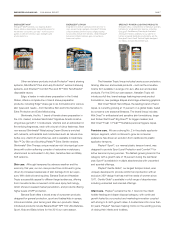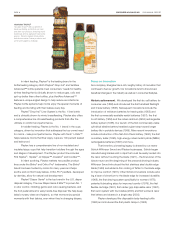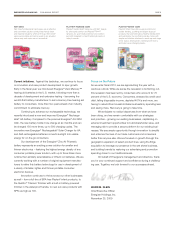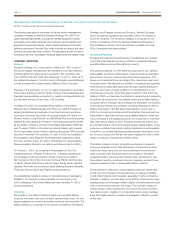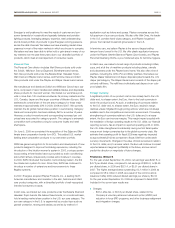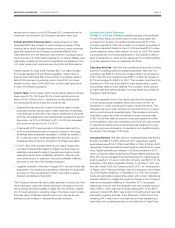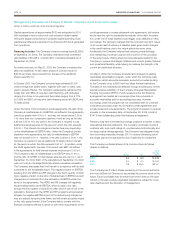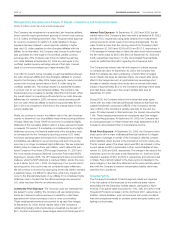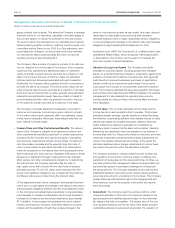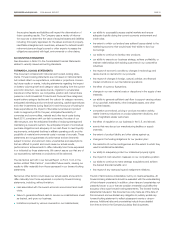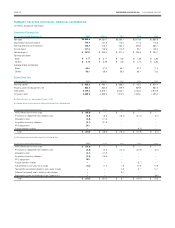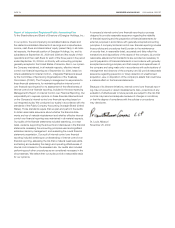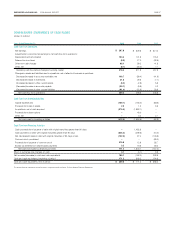Energizer 2009 Annual Report Download - page 19
Download and view the complete annual report
Please find page 19 of the 2009 Energizer annual report below. You can navigate through the pages in the report by either clicking on the pages listed below, or by using the keyword search tool below to find specific information within the annual report.
ENERGIZER HOLDINGS INC. 2009 ANNUAL REPORT PAGE 17
A summary of the Company’s significant contractual obligations at
September 30, 2009 is shown below:
Total
Less than
1 year 1-3 years 3-5 years
More than
5 years
Long-term debt,
including current
maturities
$2,389.5
$101.0
$497.0
$ 891.5
$900.0
Interest on
long-term debt
592.1
106.8
204.4
147.1
133.8
Operating leases 75.3 23.1 26.2 14.9 11.1
Purchase
obligations
and other (1)
44.1 37.5
3.4 3.2 –
Total $3,101.0 $268.4 $731.0 $1,056.7 $1,044.9
(1) The Company has estimated approximately $2.8 of cash settlements associated with unrecognized
tax benefits within the next year, which are included in the table above. As of September 30, 2009,
the Company’s Consolidated Balance Sheet reflects a liability for unrecognized tax benefits of $46.9,
excluding $7.4 of interest and penalties. The contractual obligations table above does not include this
liability. Due to the high degree of uncertainty regarding the timing of future cash outflows of liabilities
for unrecognized tax benefits beyond one year, a reasonable estimate of the period of cash settlement
for periods beyond the next twelve months cannot be made, and thus is not included in this table.
The Company has contractual purchase obligations for future
purchases, which generally extend one to three months. These
obligations are primarily purchase orders at fair value that are part of
normal operations and are reflected in historical operating cash flow
trends. In addition, the Company has various commitments related to
service and supply contracts that contain penalty provisions for early ter-
mination. As of September 30, 2009, we do not believe such purchase
obligations or termination penalties will have a significant effect on our
results of operations, financial position or liquidity position in the future.
In addition, the above contractual obligations table does not include
minimum contributions related to the Company’s retirement programs
as they are not considered material to the cash flow and liquidity of the
Company for any given fiscal year presented. The U.S. pension plans
constitute more than 70% of the total benefit obligations and plan assets
for the Company’s pension plans. At this time, we do not believe that a
minimum pension contribution for the U.S. plan will be required before
fiscal 2012, and, we do not believe such a minimum payment, if any,
will be material to the Company’s liquidity or cash flow based on current
discount rates, expected return on plan assets and plan design. Total
pension contributions for the Company in 2010 are estimated to be
approximately $19.
The Company believes cash flows from operating activities and periodic
borrowings will be adequate to meet short-term and long-term liquidity
requirements prior to the maturity of the Company’s credit facilities,
although no guarantee can be given in this regard.
Market Risk Sensitive Instruments and Positions
The market risk inherent in the Company’s financial instruments and
positions represents the potential loss arising from adverse changes
in currency rates, commodity prices, interest rates and the Com-
pany’s stock price. The following risk management discussion and
the estimated amounts generated from the sensitivity analyses are
forward-looking statements of market risk assuming certain adverse
market conditions occur. Company policy allows derivatives to be used
only for identifiable exposures and, therefore, the Company does not
enter into hedges for trading purposes where the sole objective is to
generate profits.
Currency Rate Exposure A significant portion of our product cost is
more closely tied to the U.S. dollar and, to a lesser extent, the Euro,
than to the local currencies in which the product is sold. As such, a
weakening of currencies relative to the U.S. dollar and, to a lesser
extent, the Euro, results in margin declines unless mitigated through
pricing actions, which are not always available due to the competitive
and economic environment. Conversely, strengthening of currencies
relative to the U.S. dollar and, to a lesser extent, the Euro can improve
margins. This margin impact coupled with the translation of foreign
operating results to the U.S. dollar, our financial reporting currency,
has an impact on reported operating profits. In 2009, the U.S. dollar
strengthened considerably versus most foreign currencies during our
first fiscal quarter due to the global economic crisis. We estimate that
operating profit for fiscal 2009 was negatively impacted by approxi-
mately $120 as compared to fiscal 2008 from unfavorable currency
movements. Changes in the value of local currencies in relation to the
U.S. dollar, and, to a lesser extent, the Euro will continue to impact
reported sales and segment profitability in the future, and we cannot
predict the direction or magnitude of future changes.
The Company generally views its investments in foreign subsidiaries
with a functional currency other than the U.S. dollar as long-term.
As a result, the Company does not generally hedge these net invest-
ments. Capital structuring techniques are used to manage the net
investment in foreign currencies, as necessary. Additionally, the
Company attempts to limit its U.S. dollar net monetary liabilities
in countries with unstable currencies.
From time to time the Company may employ foreign currency hedging
techniques to mitigate potential losses in earnings or cash flows on
foreign currency transactions, which primarily consist of anticipated
intercompany purchase transactions and intercompany borrowings.
External purchase transactions and intercompany dividends and
service fees with foreign currency risk may also be hedged. The
primary currencies to which the Company’s foreign affiliates are
exposed include the U.S. dollar, the Euro, the Yen, the British pound,
the Canadian dollar and the Australian dollar.
The Company uses natural hedging techniques, such as offsetting like
foreign currency cash flows, foreign currency derivatives with durations
of generally one year or less, including forward exchange contracts,
purchased put and call options and zero-cost option collars. Certain
of the foreign exchange contracts have been designated and are
accounted for as cash flow hedges.
The Company enters into foreign currency derivative contracts
to hedge existing balance sheet exposures. Any losses on these
contracts would be fully offset by exchange gains on the underlying
exposures, thus they are not subject to significant market risk. At
September 30, 2009, the Company had a loss of $1.1 included in
earnings on these unsettled forward currency contracts. In addition, the
Company has entered into a series of forward currency contracts to
hedge the cash flow uncertainty of forecasted inventory purchases due
to short term currency fluctuations. These transactions are accounted
for as cash flow hedges. At September 30, 2009, the Company had
an unrecognized pre-tax loss on these forward currency contracts
accounted for as cash flow hedges of $15.3 included in Accumulated
Other Comprehensive Income. Contract maturities for these hedges
extend into 2012.


